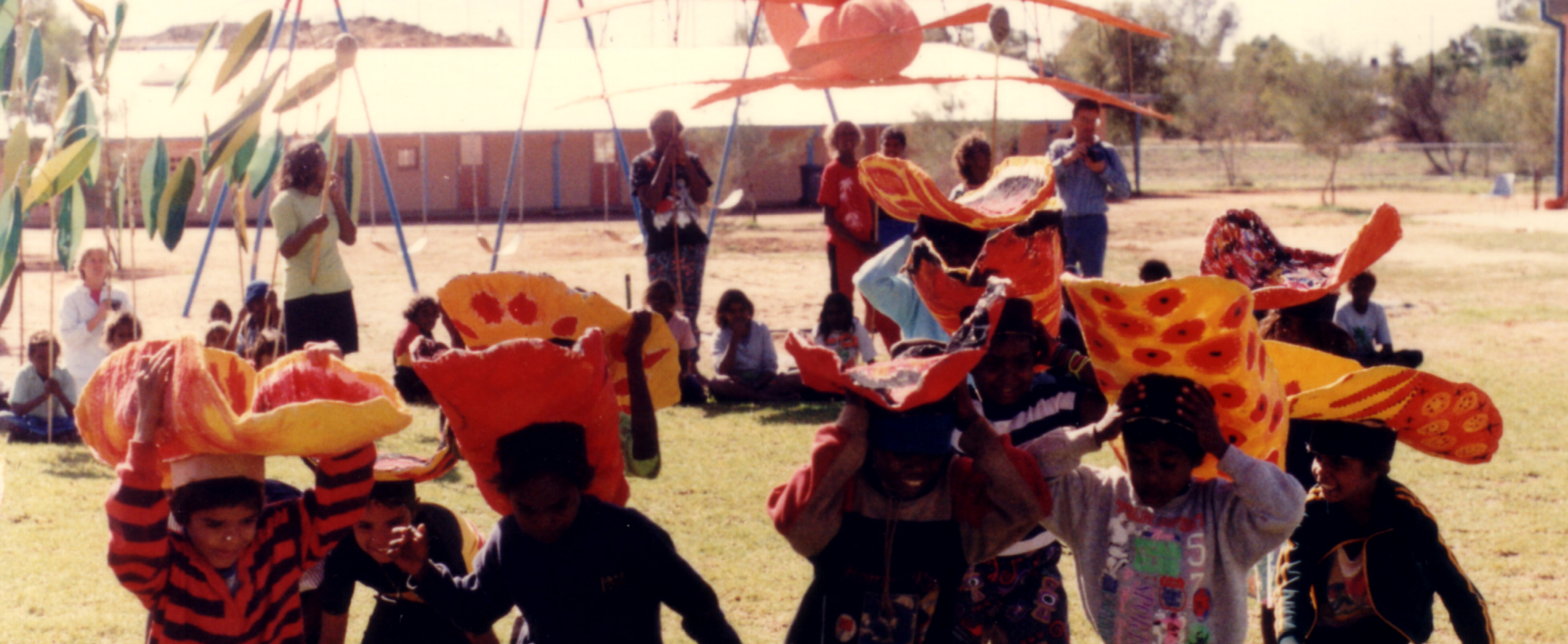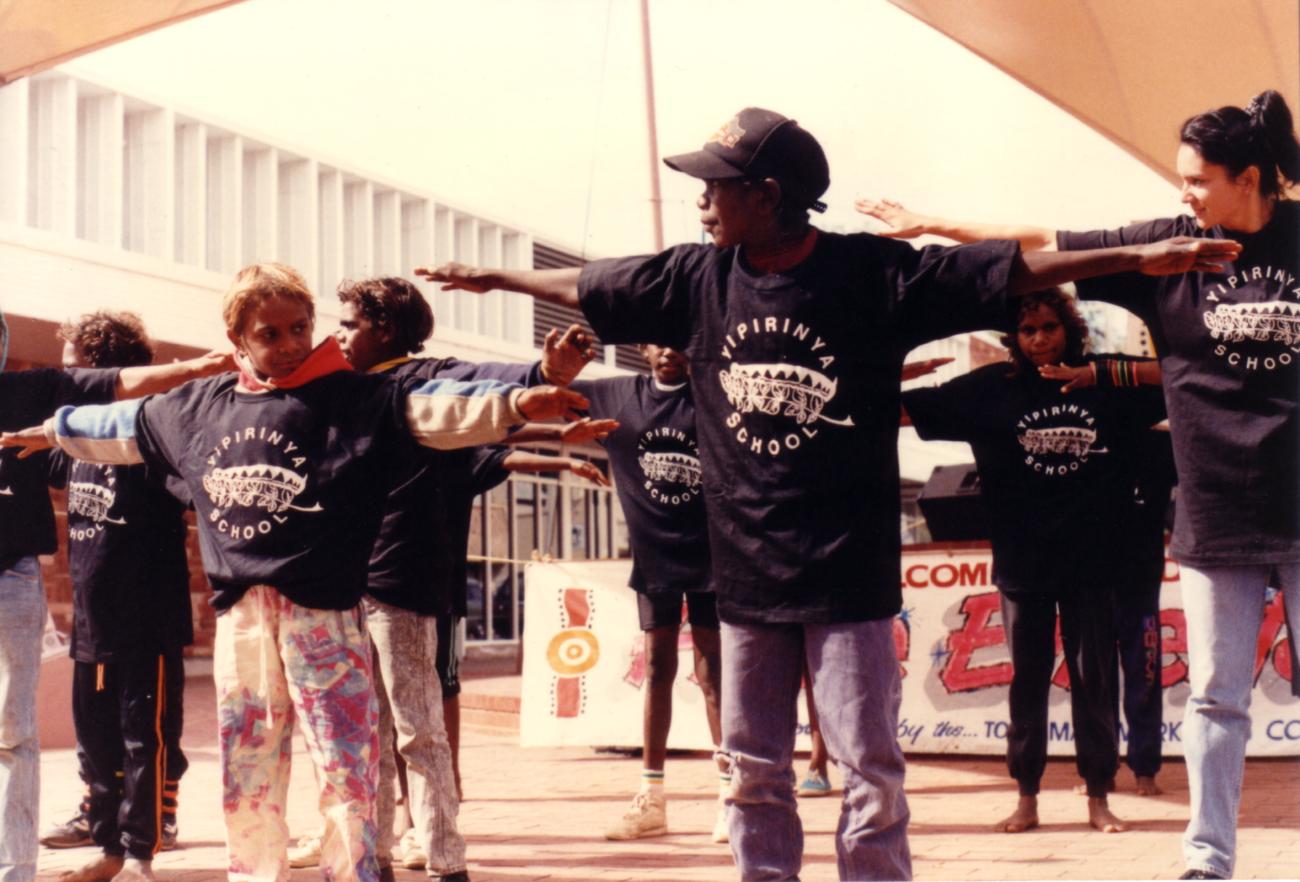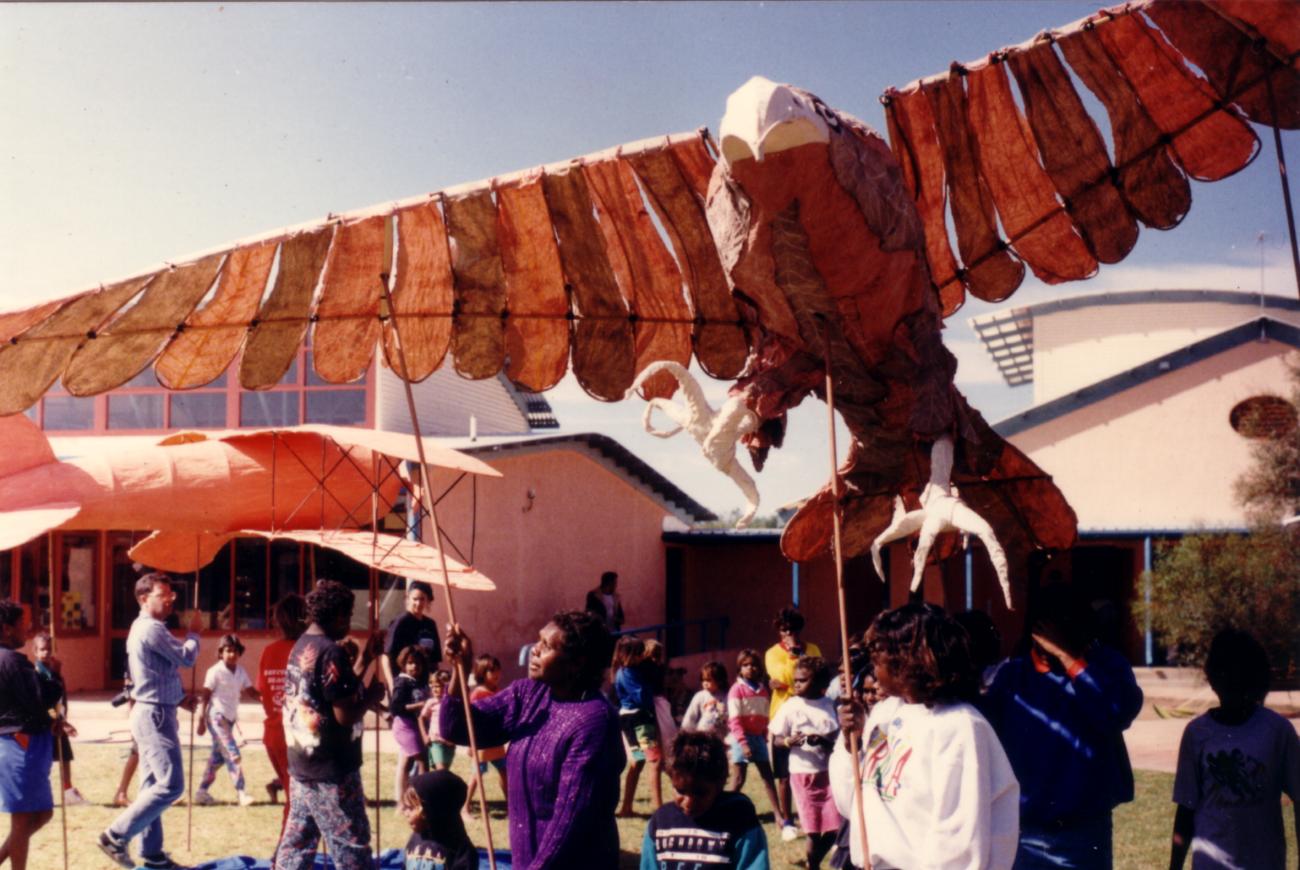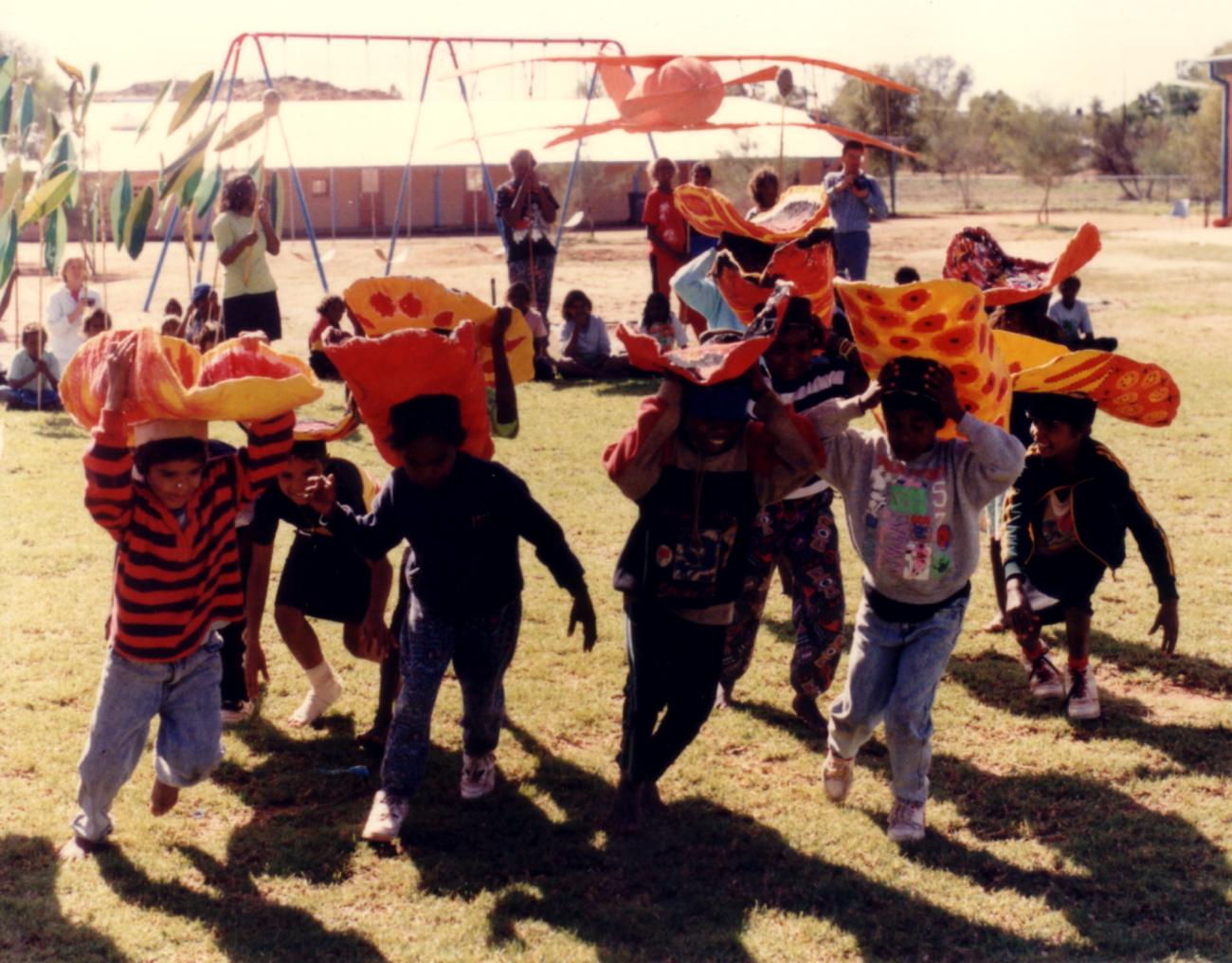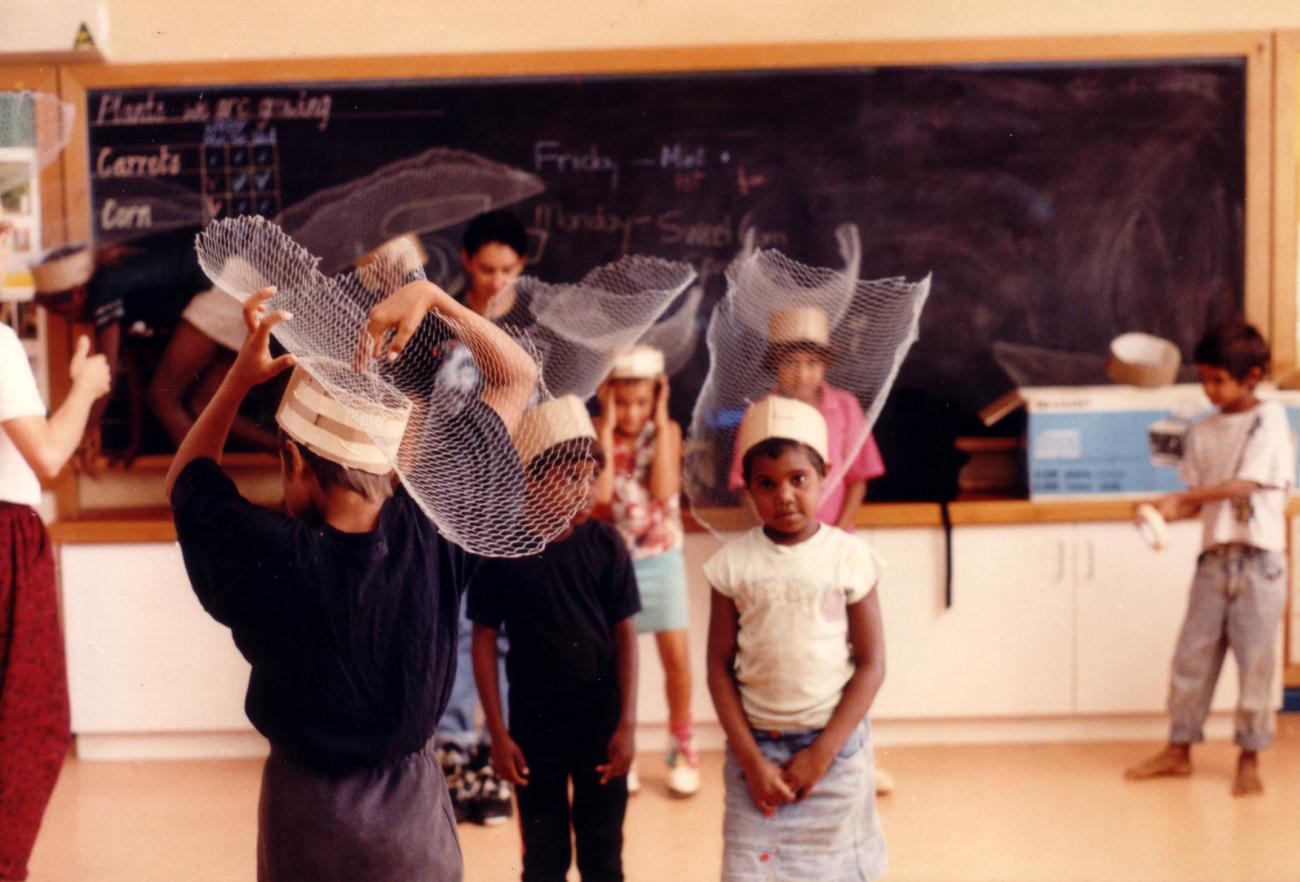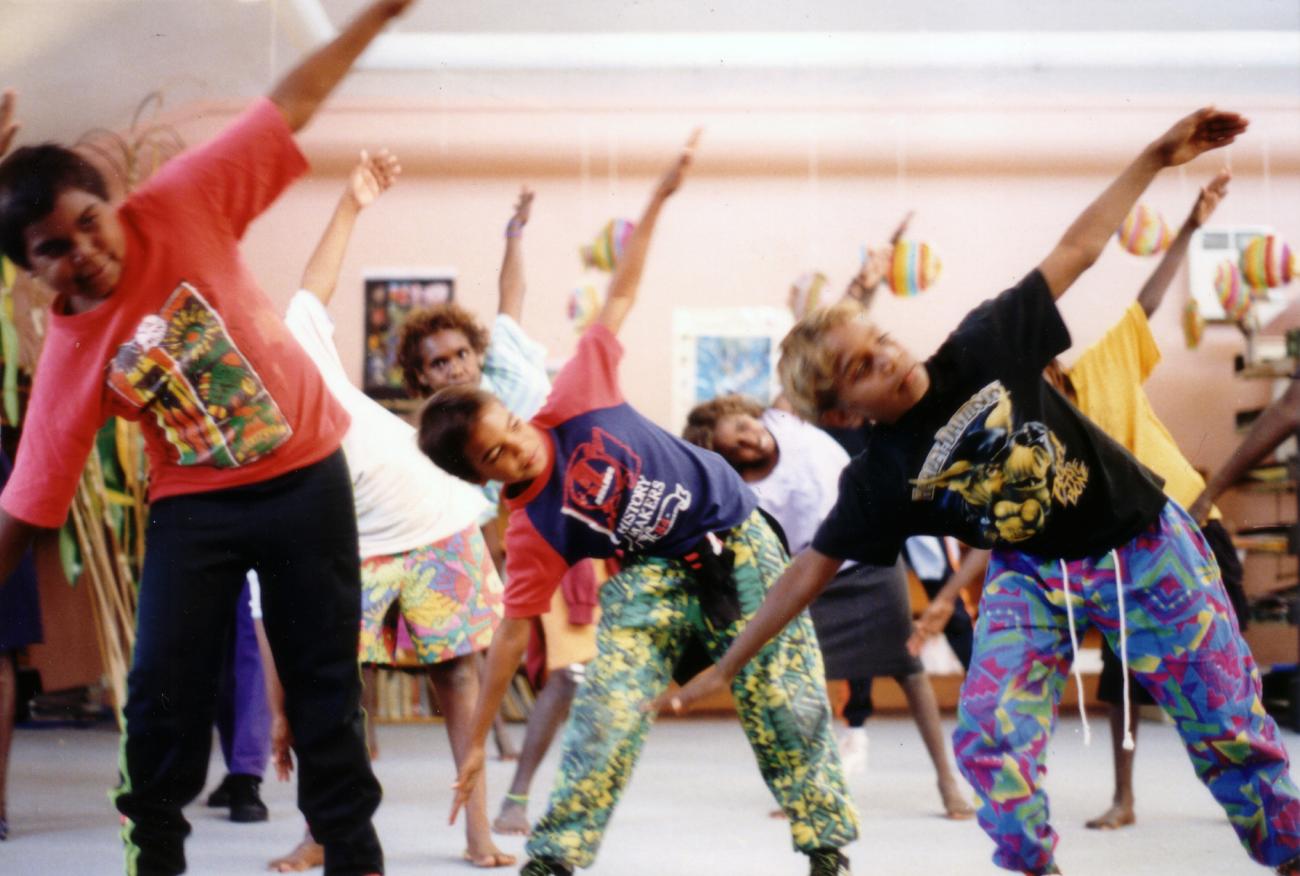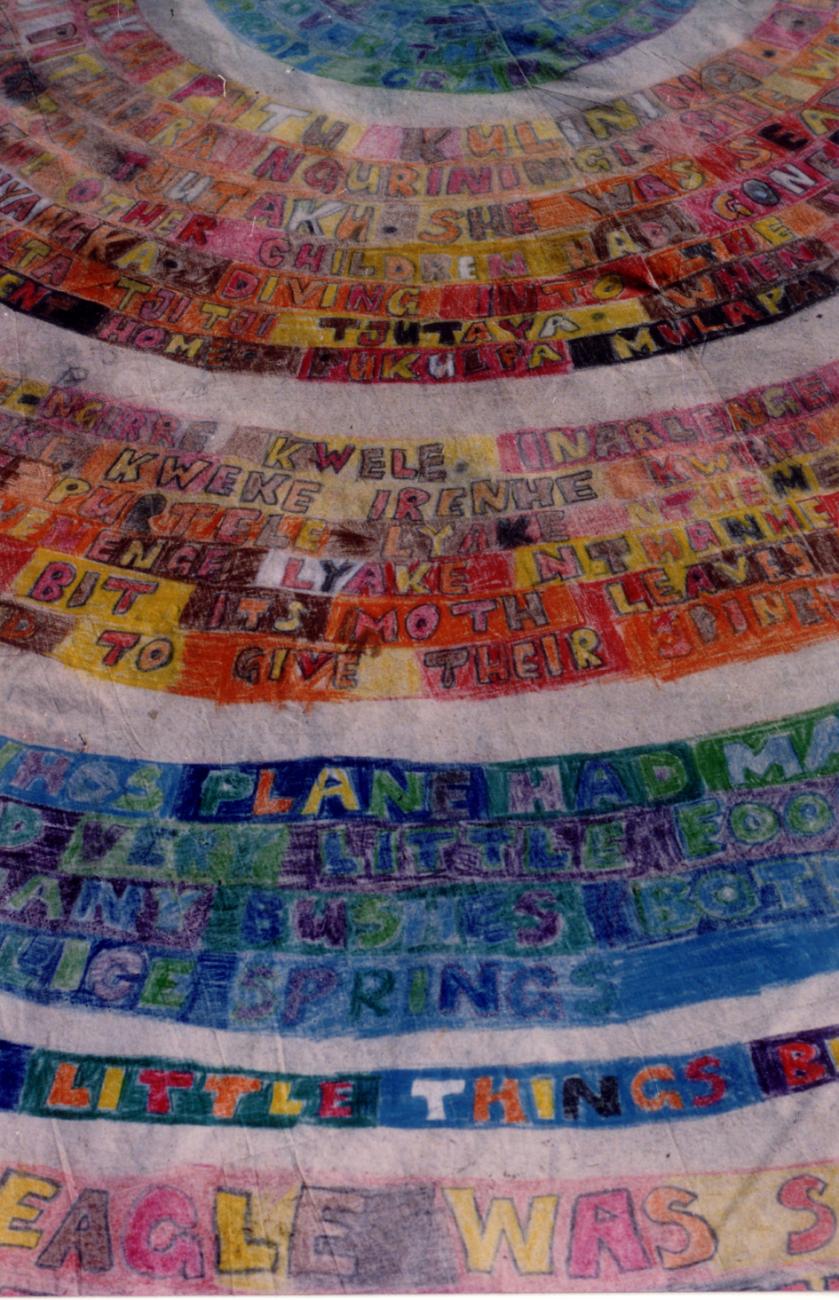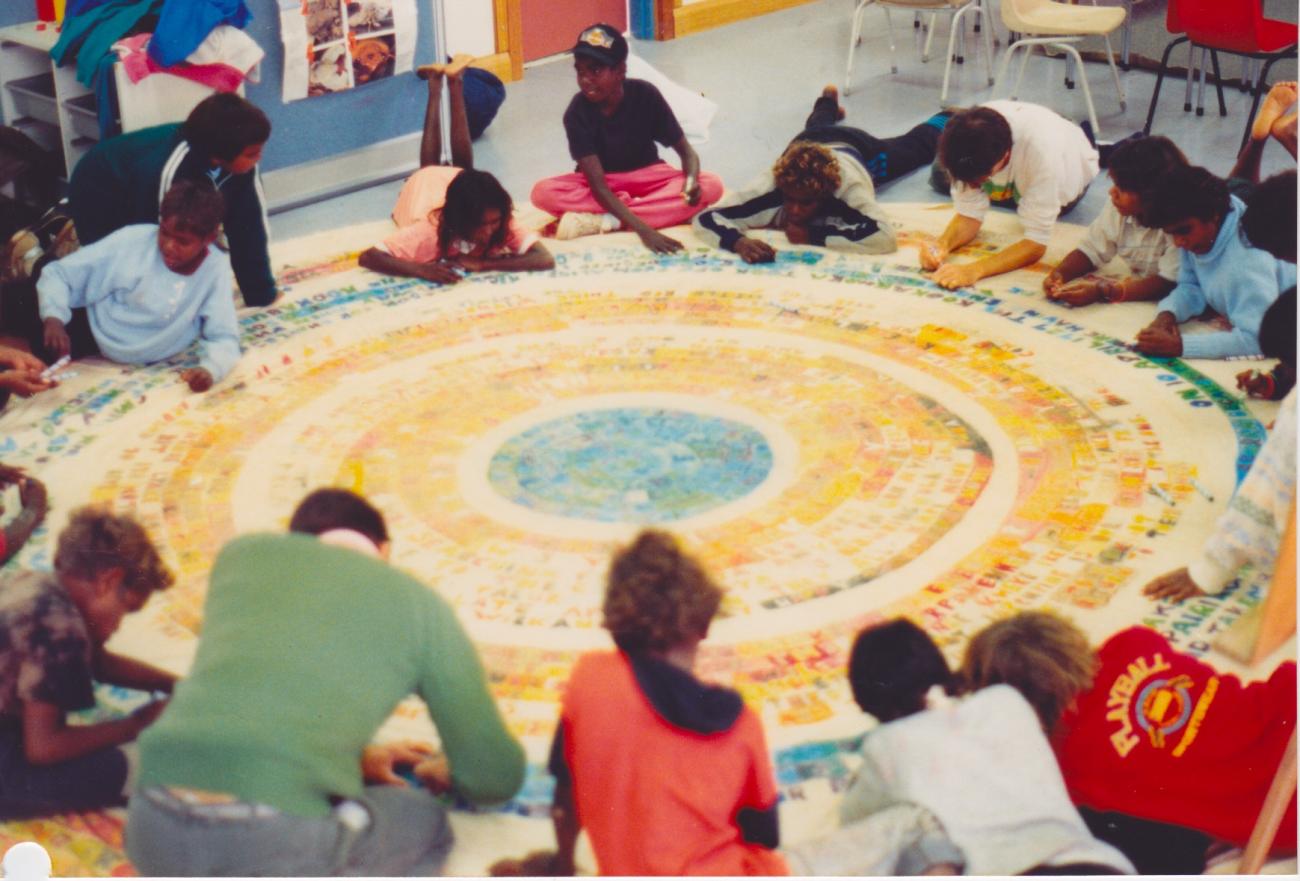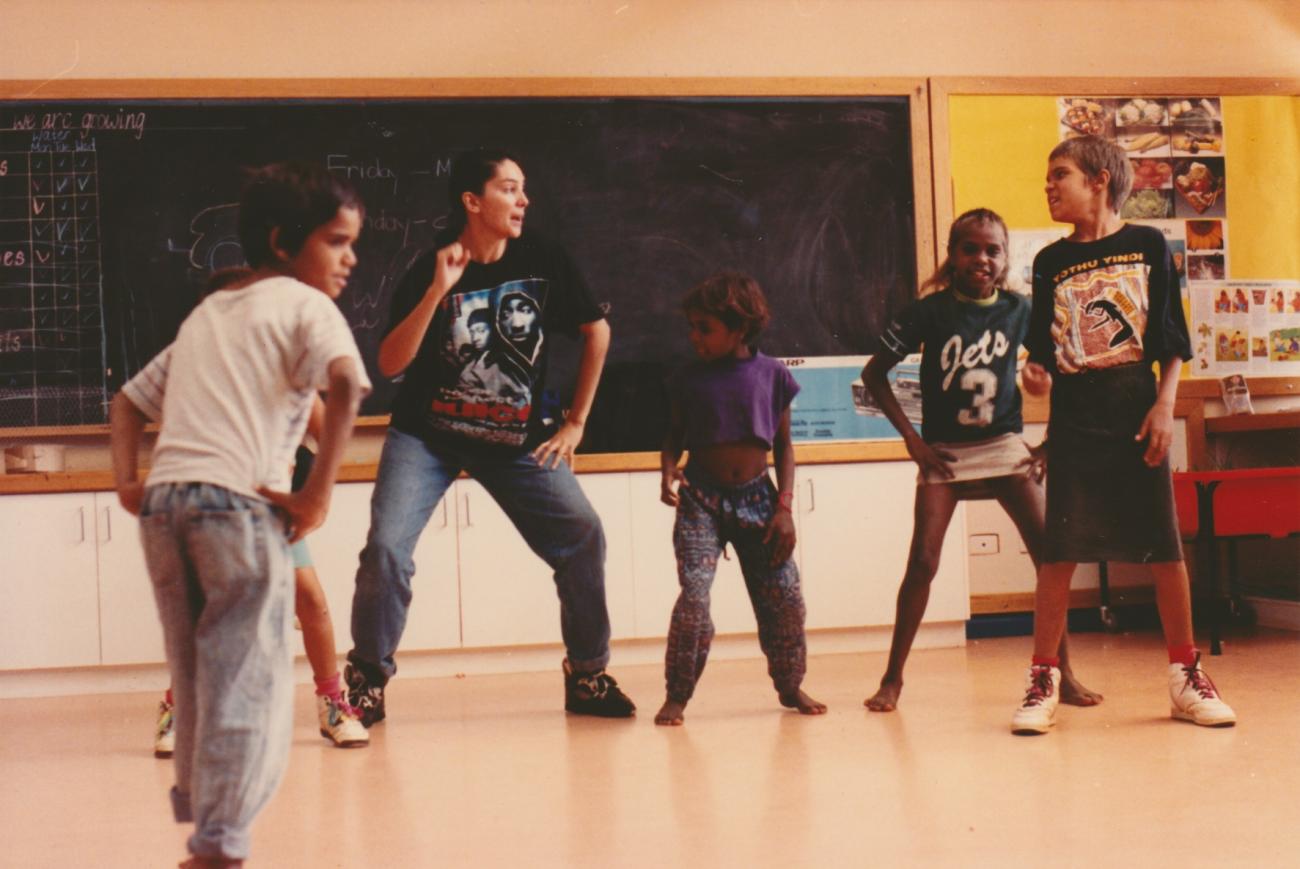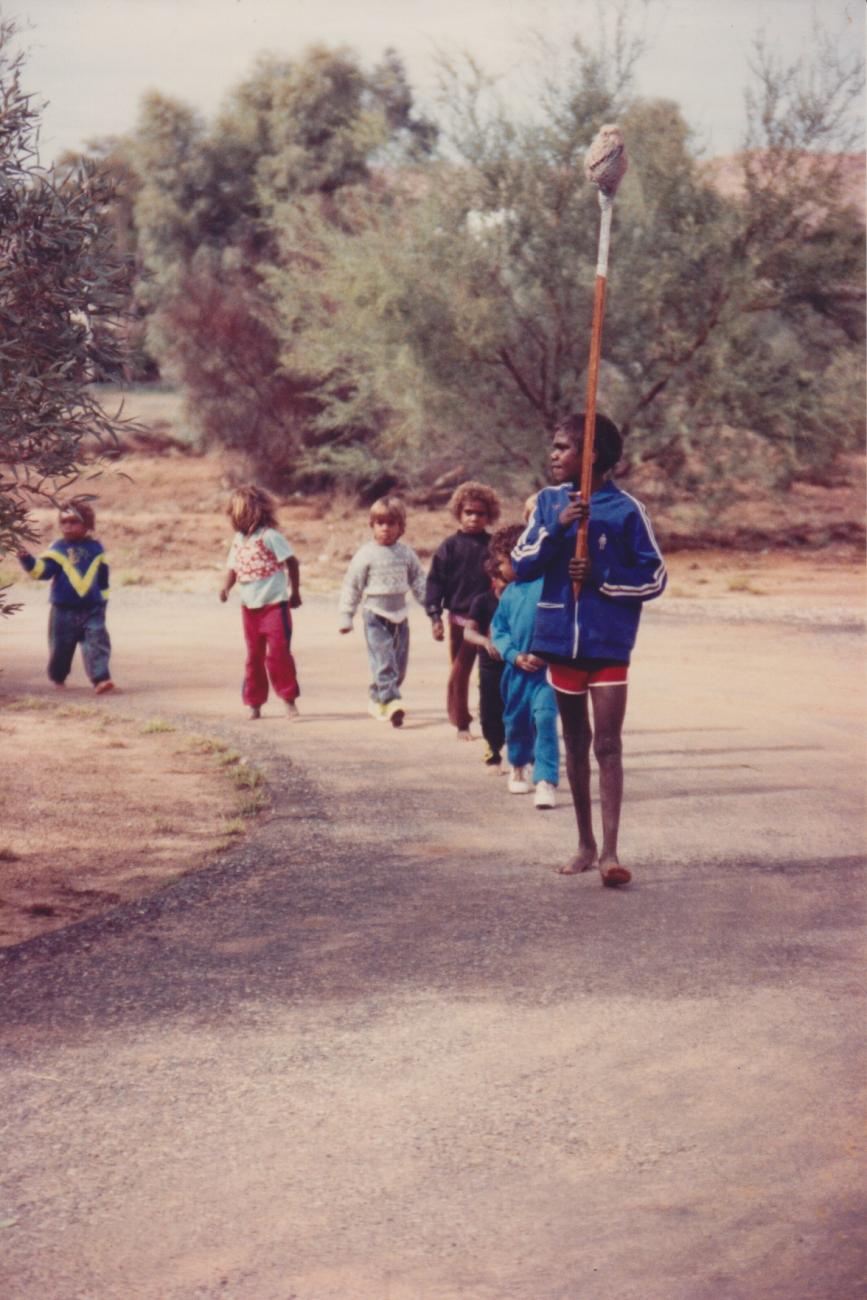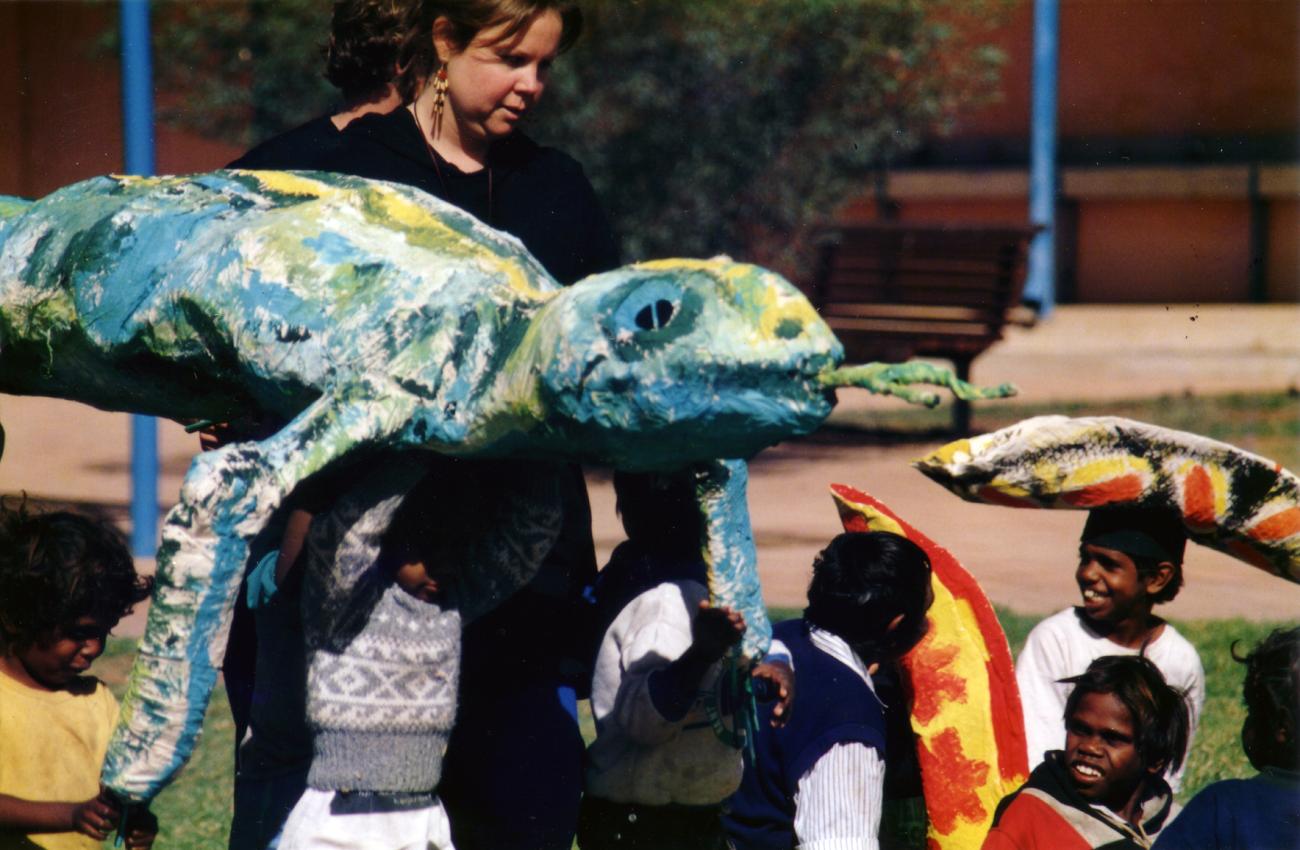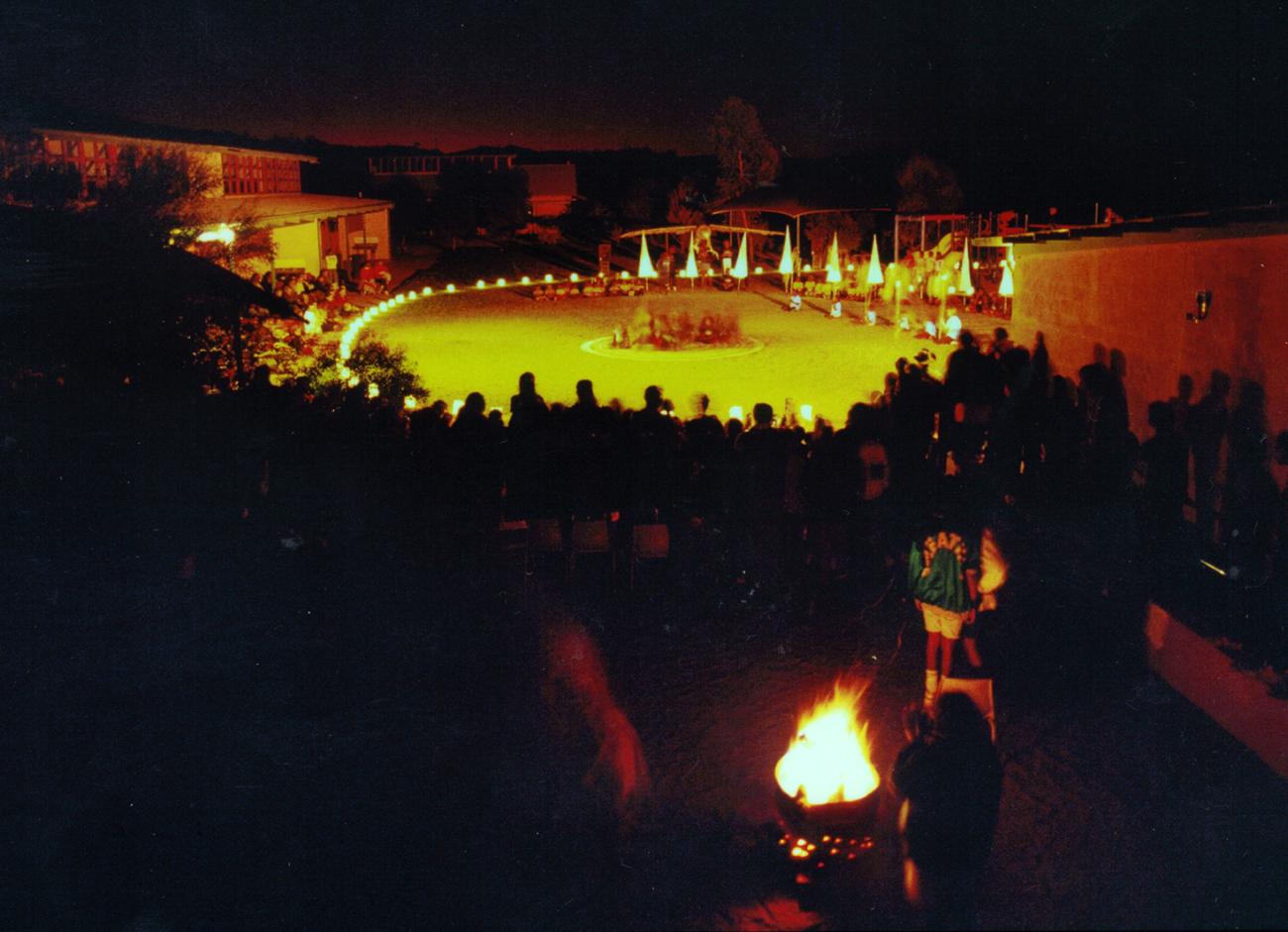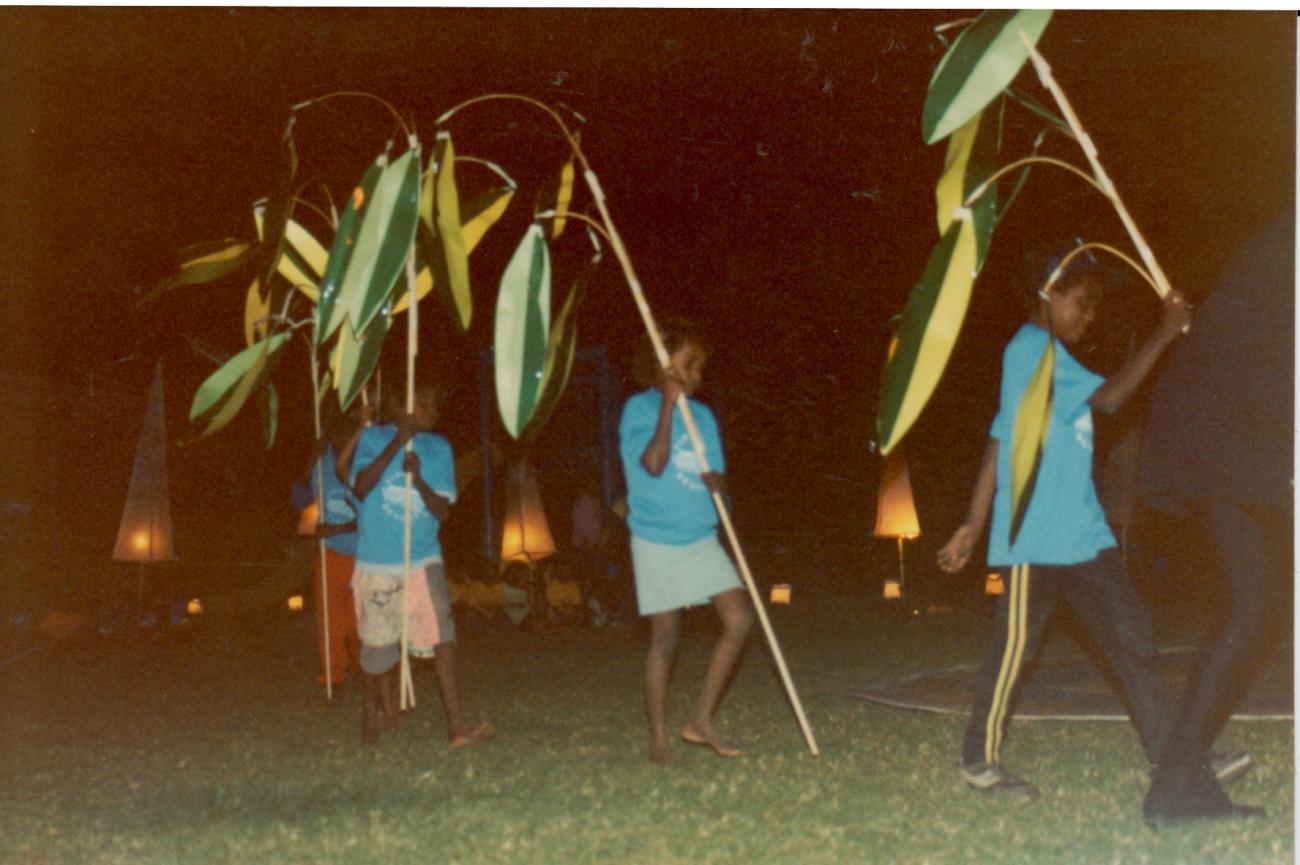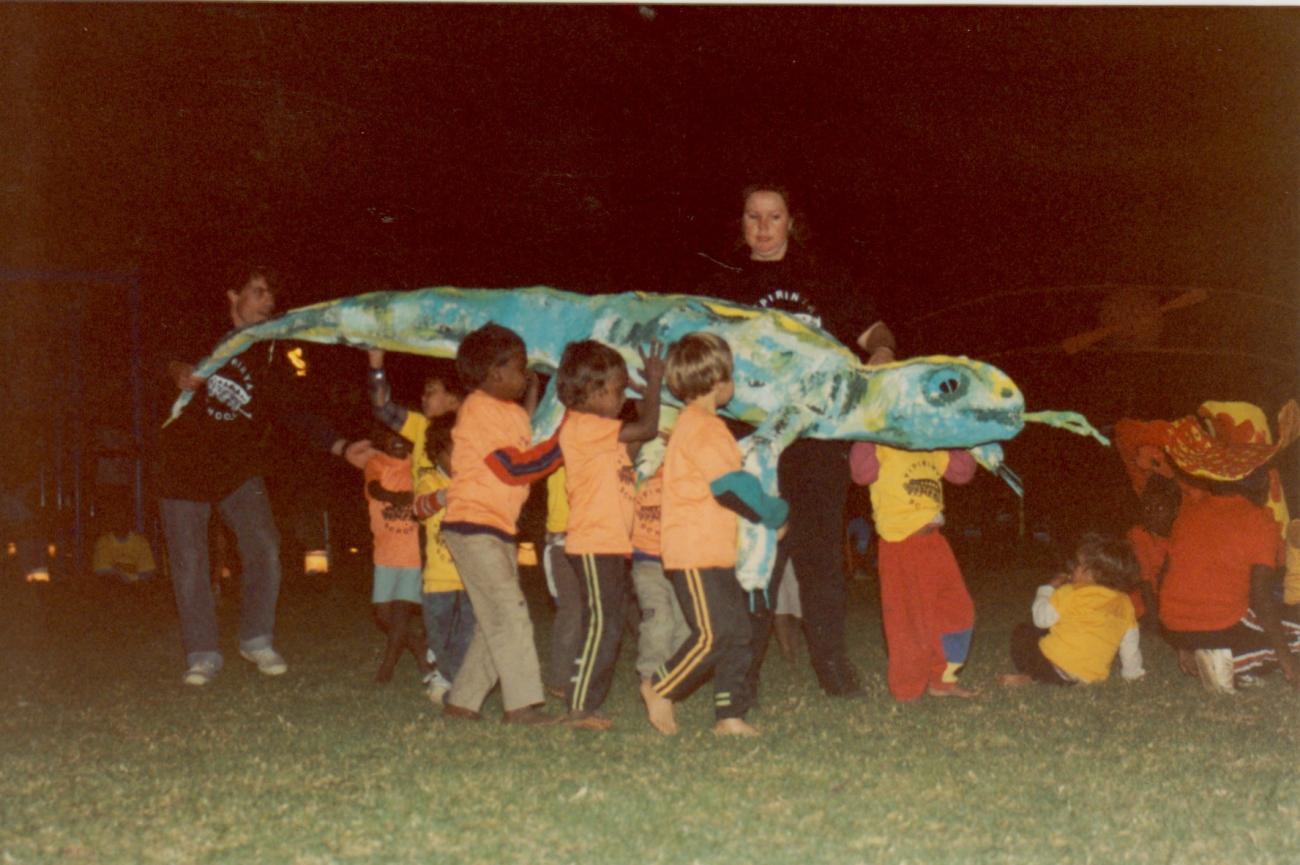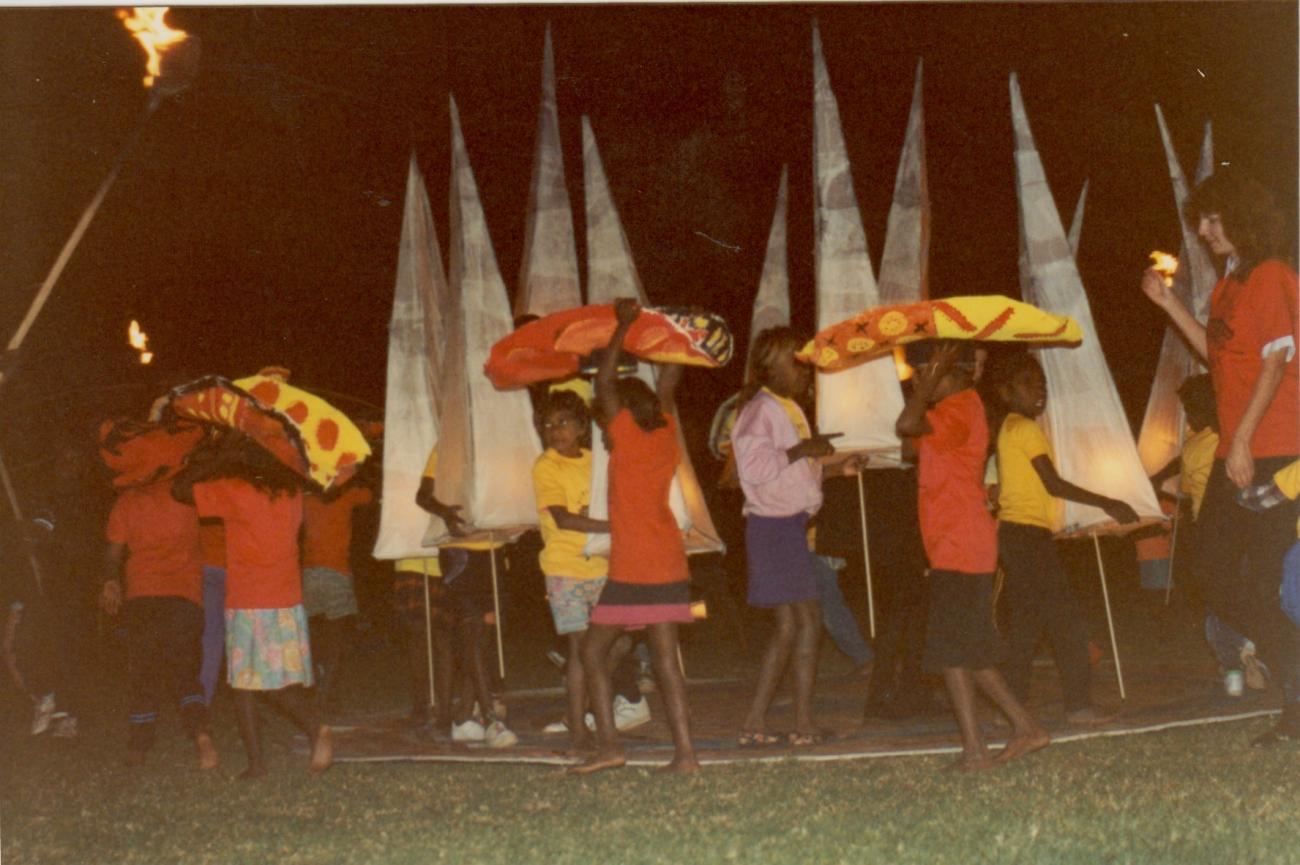From Little Things Big Things Grow - Yipirinya, Alice Springs Residency
Text
Yipirinya School Grounds, Alice Springs
May 29, 1992
This project was a result of a smaller residency attached to the Lajamanu touring projects in the late 1980’s. The school was looking for a creative way to “come together”, a difficult task when there were five different language groups and cultures, as well as many social problems attached to people living in remote places and in town camps. Tim Newth had been a key artist in the Lajamanu touring shows, residencies and a previous Yipirinya short residency. This project was David McMicken’s first foray into working in Indigenous contexts. Bronwyn Liddle was a local Indigenous woman who had previous dance training and modelling experience. She was brought on board to replace Sarah Calver who was on maternity leave.
From Little Things Big Things Grow worked within the existing school structures and syllabus, and was performed in the school grounds.
About Yipirinya School
Yipirinya School was founded as an Independent Aboriginal Community School through the initiative of Indigenous members of the local community in 1978. It is controlled by an Indigenous Council and catering for Indigenous students from Alice Springs town camps and nearby outstations. It is the true School of Alice Springs, going back to the beginning, to the Caterpillar Dreamtime.
Yipirinya School has classes from pre-school to lower secondary. The School offers a two-way (bi-lingual & bi-cultural) approach to education. Vernacular teachers offer additional support when children have vernacular language classes each day.
Directors' Notes – Tim Newth & David McMicken
In May of 1992 a performance of story, dance and visual images called "From Little Things Big Things Grow", was told in the grounds of Yipirinya school to an audience numbering over 500 people. The sunset show contained 120 performers drawn from the Luritja, Warlpiri, Western and Central Arrernte language groups, as well as a five-metre wide wedge-tail eagle, the ghost plane of the Kookaburra, lantern spines belonging to a yet to be born Echidna, Coolamon head dresses designed for easy carrying and the collection of seeds and water, one large goanna, native trees, flame torches for the hunting out of a goanna, two hundred candle lanterns and a large performance mat displaying the written stories of the show in Warlpiri, Luritja, English, Western and Central Arrernte.
"From Little Things Big Things Grow" had been inspired by the 1989 and 1990 Lajamanu touring theatre shows, in which twelve young people from Lajamanu toured the Territory with a dance, visual and circus skills-based show. It was devised with artists Sarah Calver, Robin Laurie and myself. Also in 1990 Sarah and myself ran a weeklong workshop at Yipirinya in dance and design on the invitation of the school.
The Lajamanu shows set up role models of Aboriginal people using contemporary theatre as a voice to speak up, of getting out there, and doing. In all the places toured by the Lajamanu show much interest was expressed in developing similar projects. Yet it seemed to me that Yipirinya was the most suitable, people and place wise, to house a next project.
In the lead up there had been several deaths and the school was often closed for "Sorry Business." This cannot be avoided when working with Aboriginal Communities. We had several concerns regarding the Project.
- Six weeks was a very short time. The Lajamanu projects that inspired this project had been 3 month residencies.
- Working with an artist, (Bronwyn Liddle) whose skills or interest in the type of work was unknown
- The difficulty of getting Aboriginal kids to perform. The idea is unfamiliar to them and it is not uncommon for them to "shame out" and not perform, or simply not turn up, or even walk away.
It was agreed with the school, in accordance with the grant submission, that we would take workshops and, if appropriate, a performance would be devised. This took the pressure off having to spend the entire time motivating the kids to do something that was not comfortable for them. (In Lajamanu the first month was spent simply trying to get some kids to turn up to rehearsals.)
Creative Personnel
Director/Designer: Tim Newth
Choreographer: David McMicken
Dancer/Assistant Choreographer: Bronwyn Liddle
Performers
Students and Staff of Yipirinya School – Alice Springs
Scenario
YESTERDAY
- The echidna enters but hears the hunters and burrows into the ground.
- The hunters enter but find no food so decide to plant the seeds they have gathered.
- As hunters rest, the goanna feels that it is safe to come out into the open.
- The hunters are awakened by the goannas search for food.
- The hunters burn the bush to flush out the goanna.
TODAY
- Time passes, the seeds are now big trees.
- The kids enjoy swimming in the waterhole while their mothers worry at home.
- People no longer simply walk, they drive trucks and cars.
- The mother kangaroo keeps her Joey safe from the hungry Eagle as it soars above the waterhole, but is unable to keep her Joey safe from the big truck. The hungry Eagle still gets its supper.
- The kids still enjoy the waterhole.
- The aeroplane swoops down to frighten the kids home to their worried mothers.
- A new cycle of life begins to spin.
- Our lives keep changing but we must remember
- “from little things big things grow.”
RUNNING ORDER
- Placing of floor cloth - Community Members
- Procession - Everyone
- Spine lanterns enter – Echidna dance with lanterns representing spines - Western Arrernte
- Coolamon and seed dance (hunt and gather) - Central Arrernte
- Goanna and dance - Child Care
- Flame torches (hunters) - Seniors
- Circle of life spins (yesterday) - All of 3, 4, 5, & 6
- Trees enter - Luritja
- Warlpiri Bus - Warlpiri
- Eagle enters - Warlpiri
- Tjiti Kutjungku (one child) dance - Luritja
- Plane enters and flying dance - Seniors
- Eagle and plane, circle of life spins (today) - Everyone
- Michael Jackson dance - Everyone
- From Little Things Big Things Grow - Everyone
THE CHOREOGRAPHY
CHILD CARE: (up to about four years old.) Sessions predominantly involved movement games, some involving snakes and lizards. A visual image of a goanna was created. We continued imitation of different animals for most of the sessions. This age group was of mixed language, English was not the first language, and verbal communication was limited.
The final dance for this group was a series of actions depicting the life cycle of a goanna. From an egg, to a small wriggling snake like creature, to a small lizard, to a giant standing up goanna, and finally a running goanna, returning to an egg etc. A 4-metre goanna was made. The children painted it in greens and yellows and used it in their dance.
CENTRAL ARRERNTE AND ENGLISH AS A FIRST LANGUAGE: (5 – 11 years old). This group was working on “things that grow”. Accumulating moves from each student, we created a dance that began with digging holes, planting seeds, watering them and allowing them to grow. A visit to the Strehlow Research Centre provided strong images of the Central Arrernte women carrying things in large coolamons on their heads. The art galleries in town were full of brightly painted coolamons and the hair rings that they use to balance the Coolamon on their heads. Large lightweight coolamons were made and painted with wild colours. They were worn as large hats, used to carry things, (plants, children, anything) and as shields. They were incorporated into the digging and growing dance.
LURITJA: We asked the Luritja staff member Phyllis, what was there that was particularly Luritja. She mentioned a band called the Titjikala Desert Oaks. She also had a favourite song, Tjitji Kutjungku (One Child) about a child looking for her friends. We choreographed a dance around the words of the song. (The song was sung in Luritja but the tape had a transcript in English.) Their visual images were trees that created a sense of bush. We also used a large floor cloth in the middle of the performance space and the Luritja group used this cloth as a water hole for swimming in.
WEST ARRERNTE: This class was one of the most settled classes in the school. Their theme was the echidna, (inarlenge.) We made large spiky lanterns that represented the spines of the inarlenge. It was a challenge to handle these lanterns with delicacy. A special lantern was made for one child who did not have the full use of his arm. This group created a dance around a traditional story about how the baby inarlenge was born without spines and is given them by the mother inarlenges. The overall dance used a lot more spatial patterning than other groups.
WARLPIRI: This class was the loudest and largest class in the school. Unlike the other classes it was predominantly male. It also had a large turn over. The final students were nearly all different from the start.
Noreen Nampijinpa Robinson came up with a story from a bush trip they had been on. A marlu, (kangaroo,) was relentlessly pursued by an eagle. Finally the Marlu has a baby joey. While crossing the road the mother marlu is hit by a big bus and the eagle gets a good feed, leaving the joey alone and sad.
Early workshops with this group led to the creation of a large Marlu made of many people, joeys made from two people each and eagles made from boys on others shoulders. It was impossible to recreate these structures as the students would argue as to who would be what; having been an eagle one time they would not want to repeat. A large eagle puppet was made. The adult Warlpiri women operated the bird.
It was with this class that some pertinent lessons were learnt, lessons that carried over to work with other groups.
- It was clear in this class that the senior boys decided what would happen. Other students tended to allow this, even expect it to happen. Any attempt to change this structure was ineffective.
- It was best to set a task and allow the class to solve it using their own language and all the noise they wanted.
- Aboriginal staff would help all they could but you had to almost invite them in; give them specific task to solve, i.e. could you make sure they understand.
- Movement had to be choreographed that did not rely on any particular person because in the following class they may not be there.
- Trying to get the boys and the girls to work together is often nearly impossible. If two groups are needed then it is better to split according to gender.
The dance for this group was in two sections. Firstly, a bus trip used jumps, rolls on the ground, falling all over each other, generally a very loose order of several structured actions, done to a song called Black Boy by an Aboriginal band The Wedgetail Eagle Band.
At the end of the bus trip we told the eagle and Marlu story. Using the Luritja's trees as cover for the kangaroos the story unfolded to a song by the North Tanami Band (Warlpiri) called Mardaka Nyanu. The song says “keep your law and your culture”. The eagle puppet flies in at the end and picks up everybody having a great feed.
SENIOR CLASS. This class’s theme was “flying”. Their dance used contact and counterbalance. This was the only class that responded to this type of movement. With the seniors we could deal with mechanical and engineering notions of balance. Their English language skills were better. (The senior class was mixed language groups and all their teaching was done in English, although they are free to discuss in their own languages while working.) The separation of the sexes is distinct by this age. With great effort you could get the boys and girls close to each other but that was it. There are some rivalries between language groups and what was going on in the town camps effected this group of young adults.
Nevertheless, a flying dance was created and performed to Yothu Yindi's extended mix of Djapana. Compared to other groups, these students were able to work to the musical structure of the song, and dance almost unsupervised. We performed this section of the dance at a performance in the city mall. This was a highlight for this group as they do not usually perform publicly, especially not to a white audience. Their apparent confidence and no fuss performance was a surprise to their teacher who felt beforehand that they would not get up and perform. (We had already come upon this "shame" notion with the Warlpiri kids who at times simply refuse to show their work to other people.)
The visual image for this group was a large biplane, carried above their heads.
THE ENTIRE SCHOOL: From the outset we knew that we wanted an up-tempo, contemporary pop/techno dance for everyone in the school. We chose Michael Jackson's Black Or White. This dance was to be the main area of work for Bronwyn Liddle. We separated the dance into two sections; one for the boys and one for the girls, utilising social structures that were already part of their lives. The dance was made up of short phrases and allowed the students to perform full out and then run away to the back. This was the way they were used to dancing.
From single language groups we progressed to all the boys and all the girls (Michael Jackson dance) and finally arrived at everybody. The final dance was done to a section of Paul Kelly singing (our theme) From Little Things Big Things Grow. This took movements from everybody's sections.
IN CONCLUSION:
Choreographing material for this kind of show has several problems and many joys. It was difficult not being able to set very much as one never knew who was actually going to perform the material. The short rehearsal time meant that the children only had trust in us and themselves towards the end of the project.
The success of this project was in the integration of the visual imagery with the movement, and the rehearsal/showings towards the end.
It was decided that every day for the final two weeks we would show, as part of a school assembly, material from different groups. This built up so that several groups could show together. This had two benefits: as well as showing others what the stories were, it also showed the students things about being an audience. This was a skill that was needed for this show because for a lot of the time they would be sitting on the edges and watching. These showings of work finally concluded in running the entire show. By this stage we had the news team, the radio stations, and the newspapers. This gave the kids an extra lift, showing the work to outside people. This culminated in the senior class performing in the Mall on the day of their evening performance.
The use of all students, all staff (Aboriginal, European, administrative, Language Centre, grounds people, canteen) and some parents reminded everyone that they were part of a unique and special community. Now there is a large group of people who have the necessary skills, both in making and dancing/choreographing. They want to use these skills and next time they would be far more prepared to take the initiative and lead the project in the directions that they want to go.
1992
Dance Development Office: David McMicken
[Under Brown’s Mart Community Arts – Executive Officer Ken Conway]
Photos
Videos
Explore Further
Responses
"Fast-paced Event has ‘em spellbound. The faces of the young boys and girls grinned from the moment they started marching into the performance area to the moment they left, and the faces of the audience grinned back …The audience sat, stood and knelt spell bound throughout the show, thoroughly enjoying each moment of watching just as much as each child enjoyed performing." Centralian Advocate
"I did not really believe that they would do it. They performed so well with no mucking around."
"It was very motivating and unifying for the staff. Far more than ever expected."
"Fantastic performance, contact with outside world showing them the school and what we can do."
"Growth of team spirit from first meeting to now. Seeing kids come together at end, especially the difficult ones."
"Coming together of staff and students. Overtaking daily bickering and isolated sections in the school. It was easy to tell people to come to the show."
"Seeing the process, from nothing to the show, proves that it is possible to make things happen, that team work works. The morale of the school has been lifted. A boost to the community to see that Yipirinya "is" achieving something."
Responses from staff

